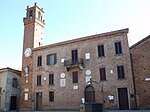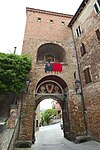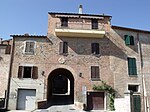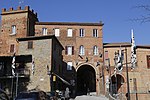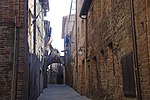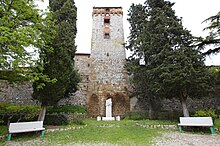Torrita di Siena
| Torrita di Siena | ||
|---|---|---|

|
|
|
| Country | Italy | |
| region | Tuscany | |
| province | Siena (SI) | |
| Coordinates | 43 ° 10 ′ N , 11 ° 46 ′ E | |
| height | 325 m slm | |
| surface | 58.36 km² | |
| Residents | 7,153 (Dec. 31, 2019) | |
| Population density | 123 inhabitants / km² | |
| Post Code | 53049 | |
| prefix | 0577 | |
| ISTAT number | 052035 | |
| Popular name | Torritesi | |
| Patron saint |
San Costanzo (January 29th) |
|
| Website | Torrita di Siena | |
 Panorama of Torrita di Siena |
||
Torrita di Siena is an Italian commune with 7153 inhabitants (as of December 31, 2019) in the province of Siena in the Tuscany region .
geography
Torrita di Siena is located in the western part of the Chiana Valley (Valdichiana), about 40 km southeast of the provincial capital Siena and 80 km southeast of the regional capital Florence on the historic Via Clodia on the Chiusi - Arezzo section . The state capital Rome is about 150 km southeast. Torrita di Siena is in the climatic classification of Italian municipalities in zone D, 1899 GR / G. Important bodies of water in the municipality are the Torrenti Salarco (2 of 15 km in the municipality, Arno river system ) and Trove (3 of 16 km in the municipality, Ombrone river system ).
About 10 km south of Montefollonico is the only district ( frazione ) of Torrita.
The neighboring municipalities are Cortona ( AR ), Montepulciano , Pienza , Sinalunga and Trequanda .
history

The name Torrita is mentioned for the first time in the Codice Amiatino of the monastery of San Salvatore di Monte Amiata in 1037 , when there was a dispute over the Pieve Sant'Apollinare in Feroniano under Conrad II . On May 2nd, 1324 this was confirmed again by the monastery and assigned to the area of Montefollonico (and thus that of Torrita). The next documented mention of the place took place in 1051, when Heinrich III. confirmed the place as belonging to the Abbey of Sant'Antimo . On August 27, 1210 Otto IV subordinated the place together with the castles Ripa, Fratta and Bettolle to the Cacciaconti family, who were under the influence of the government in Siena. The place took part in the battle of Montaperti on the side of Siena in 1260 and was badly damaged in 1288 in the conflict with Arezzo . In 1322 the place was occupied by the Republic of Siena when Torrita gave refuge to Deo Tolomei, who was exiled in Siena. The occupation was only dissolved in 1342 and trust was restored to the place. Since then, the castle served the sovereignty and defense of the Republic of Siena (1125–1555) and was surrounded by a city wall with corner towers and three city gates. The main gate Porta Gavina and the Porta a Pago were the only access points until the middle of the 16th century, when the Porta a Sole was also built. The fourth and largest city gate, Porta Nova, is not a historic city gate as it was only opened in 1835 to solve the traffic problems (with the three too small city gates). In addition, the place was strategically important for Siena, for example on the eastern outer border of the republic, bordering Arezzo, Montepulciano and Perugia , which were temporarily allied with the archenemy Florence. In 1358 the Battaglia di Torrita took place, in which Siena and Perugia faced each other, and in which Siena was defeated. Already five years later the Battaglia di Valdichiana took place at almost the same place , which this time turned out favorably for Siena under the commandant Franco Orsini. For this occasion Lippo Vanni painted the fresco La battaglia di Valdichiana in the Palazzo Pubblico (Sala del Mappamondo) in Siena. As early as 1383, the place experienced the next war, in which Torrita was attacked and destroyed by Baldovino da Panicale ( Perugia province ). As a result, the city walls were repaired by Siena from 1389 (until around 1413). These were again badly damaged in 1431 when Florence attacked the place with the help of Pitigliano and Montepulciano. For the repairs, the residents were charged with special taxes until at least 1455. The place also withstood an attack from Florence in 1477 when Carlo da Montone (Carlo Fortebracci, 1421–1479), a son of Braccio da Montone , wanted to take the place for Florence. Four years later, Torrita di Siena was attacked again by troops from Pitigliano (with support from Florence), who were stationed in Foiano della Chiana and wanted to take advantage of the political situation in Siena . At the beginning of the 16th century, the Senese ruler Pandolfo Petrucci settled in a residence, probably to keep an eye on Montepulciano and its ally Florence. The city walls were then expanded in the 16th century by the Senese during their conflict with Montepulciano by Baldassare Peruzzi from 1528. On June 8, 1554, Torrita was conquered by Florence and thus fell under the control of the Medici . As a result, Siena was robbed of its granary . Siena itself fell on April 25, 1555 after several months of siege.
On June 7, 2016, representatives of the Partito Democratico , which is the majority leader in both communities, agreed to merge Torritas with the neighboring community of Montepulciano . This was rejected in a referendum in November 2018.
Attractions
- Palazzo Comunale , formerly Palazzo Pretorio or Palazzo del Podestà , town hall with clock tower (Torre dell'Orologio) on the main square, Piazza Matteotti , built between 1210 and 1220.
- Porta Gavina , the main gate of the city; next to the Porta a Pago one of the two oldest gates. Until the middle of the 16th century, the gate had a front gate (Anitporto). Significantly damaged in the war between Florence and Siena and repaired until 1622, then restored in 1878.
- Porta a Pago , western city gate and next to Porta Gavina one of the two oldest gates.
- Porta a Sole , the eastern city gate, was built in the middle of the 16th century (around 1550).
- Porta Nova , city gate opened in 1835 to solve the traffic problems (with the three too small city gates).
- Teatro Comunale degli Oscuri , theater in the town center, inaugurated in 1870 and renovated from 1982 to 1986.
Churches

- Collegiata dei Santi Martino e Costanzo , built in 1631 and named a collegiate church in 1648 in the town center. Was expanded in 1648 and 1789.
- Chiesa delle Sante Flora e Lucilla , Romanesque style church on the main square . Here are the works of art Sangue del Redentore ( attributed to Donatello , 1430), L'Annunciazione (1592, Francesco Vanni ). Madonna col Bambino, angeli e santi (from the environment of Sodoma ), Il Presepe by Taddeo di Bartolo , Santi Andrea e Giovanni ( Benvenuto di Giovanni , 1497) and Crocifissione (Michele di Matteo, 1444).
- Chiesa di Santa Croce , church in the town center from 1642, contains the work Vergine Assunta adorata dai Santi Carlo Borromeo e Francesco ( attributed to Il Rustichino ).
- Chiesa della Santissima Annunziata , former church in the town center. Originated in the middle of the 16th century.
- Chiesa della Madonna delle Nevi , built in 1525 and integrated into the city wall. The main artist of the church was Girolamo di Benvenuto , who created the frescoes Annunciazione , Padre Eterno che invia a Maria lo Spirito Santo , Santi Costanzo e Sebastiano , Santi Flora e Rocco , Assunzione della Vergine e San Tommaso apostolo che riceve la cintola , Salvatore con ai lati Patriarchi e Profeti del Vecchio Testamento , Santi Pietro e Paolo and Sante Flora e Lucilla .
- Chiesa della Madonna della Pace , former church just outside the Porta Gavina. Originated in the 16th century.
- Chiesa della Madonna dell'Olivo , church built in 1425 outside the city walls. Originated on the site of the Pieve di San Costanzo a Scanello (mentioned in 1037), which was demolished due to the construction of the church. The campanile was added in 1818.
- Chiesa della Madonna del Rosario , church near the train station in Torrita di Siena.
- Chiesa di San Lorenzo a Ciliano , church on the road to Montepulciano.
- Pieve di San Valentino in Casale Ursina , Pieve on the road to Montepulciano. Was built over an older church mentioned in 714.
- Chiesa della Madonna delle Fonti a Giano , church on the road to Sinalunga, built in 1665. Contains the canvas painting Santo adorante il Crocifisso by Francesco Franci from 1698 .
The district of Montefollonico
The only district of Torrita di Siena is the 10 km south of Montefollonico , which is surrounded by the Chiana (north) and Orciatal (south). The district was awarded the Bandiera Arancione by the Touring Club Italiano and is located on a hill (575 m) and thus approx. 250 m higher than the main town of Torrita. The place name comes from the activity of themselves to fulling wool ( Walken ) of wool .
Events
- Palio dei Somari (German: The donkey's Palio ) takes place annually on the Sunday after March 19th (or on the same day, if this is a Sunday). In this donkey race, which has been carried out since 1966 and based on the Palio di Siena , the 8 contraden (districts) compete against each other. The four contrades of the historic old town (named after the city gates: Porta a Pago, Porta a Sole, Porta Gavina and Porta Nova) and the four "new" contrades outside the historic city walls take part: Stazione, Refenero, Fonti a Giano and Cavone. The event takes place in the Piazza Gioco del Pallone just outside the city walls near the church Chiesa della Madonna delle Nevi . Similar to the Palio of Siena, extraordinary Palios also take place here on special events, but in more frequent numbers, such as B. 1976, 1978, 1987, 1992, 1995, 2000 and 2006. They are also run at night. In contrast to the Senese Palio, the Palio dei Somari takes place only once a year and this at a relatively early point in the year.
- Torrita Blues Festival , has been held every year around the end of June since 1989. So far it has performed under other artists such as Canned Heat or Roy Rogers .
- The Borgo dei libri , a book market, takes place in the historic center every year from early to mid-May.
traffic
- Torrita di Siena is about 6 km from the motorway junction and the Val di Chiana / Bettolle junction on the A1 (part of the Autostrada del Sole ).
- The place is also on the road SS326, which connects Siena with the A1 and the Raccordo Autostradale 6 to Perugia . The Sinalunga junction is about 7 km from Torrita.
- The Torrita di Siena stop is on the Empoli – Siena – Chiusi line .
Sons and daughters of the church
- Jacopo Torriti (date of birth and death unknown), Franciscan, painter and mosaic artist
literature
- Torrita di Siena e Montefollonico. Viti e Riccucci Edizioni, Sinalunga 1990
- Accademia dei Rozzi, Ettore Pellegrini (ed.): Fortificare con arte. Vicende storiche ed architettoniche di quattro castelli senesi. Torrita di Siena, Sarteano, Lucignano della Chiana, Caldana di Maremma. Editrice Il Lecchio, Siena / Monteriggioni 2009
- Laura Martini (ed.): I Luoghi della Fede: Montepulciano e la Valdichiana senese. Arnoldo Mondadori Editore , Milan 1999, ISBN 88-04-46787-8 , pp. 93-105.
- Paola Paolini, Annamaria Russo: Le mura di Montefollonico e di Torrita. B&B Editrice, Torrita di Siena 1992
- Emanuele Repetti: Dizionario Geografico Fisico Storico della Toscana. Online edition of the University of Siena on Torrita di Siena
- Touring Club Italiano : Toscana. Milan 2003, ISBN 978-88-365-2767-0 , pp. 750 f.
Web links
- Official website of the municipality of Torrita di Siena
- Website of the Pro Loco Torrita di Siena
- Information about the district of Montefollonico
- Information about the Torrita Blues Festival
Individual evidence
- ↑ Statistiche demografiche ISTAT. Monthly population statistics of the Istituto Nazionale di Statistica , as of December 31 of 2019.
- ^ Website of the Pro Loco Torrita to San Costanzo, accessed on September 24, 2010 (ital.)
- ↑ Website of the Agenzia nazionale per le nuove tecnologie, l'energia e lo sviluppo economico sostenibile (ENEA), accessed on January 26, 2013 (Italian) (PDF; 330 kB)
- ↑ Official website of the Sistema Informativo Ambientale della Regione Toscana (SIRA) on the rivers in Torrita di Siena , accessed on September 12, 2015 (Italian)
- ↑ Official website of ISTAT ( Istituto Nazionale di Statistica ) on 2001 population figures in the province of Siena, accessed on September 12, 2015 (Italian)
- ↑ a b c d e f g h i Sara del Santo: Le mura e le porte di Torrita. In: Accademia dei Rozzi, Ettore Pellegrini (ed.): Fortificare con arte. Vicende storiche ed architettoniche di quattro castelli senesi.
- ↑ Official website of the municipality of Torrita di Siena on local history, accessed on August 20, 2017 (Italian)
- ↑ a b c d e f g h Laura Martini (ed.): I Luoghi della Fede: Montepulciano e la Valdichiana senese.
- ↑ Pier Luigi Falaschi: Fortebracci, Carlo. In: Dizionario Biografico degli Italiani , Volume 49 (1997)
- ↑ La Nazione: Fusione dei comuni, i risultati dei referendum. Il sì prevale solo ad Asciano, no da Rapolano, Montepulciano e Torrita. Retrieved November 13, 2018 (Italian)
- ↑ Official website of the municipality of Torrita di Siena for the Teatro Comunale degli Oscuri, accessed on September 14, 2015 (Italian) ( Memento of the original from March 4, 2016 in the Internet Archive ) Info: The archive link has been inserted automatically and has not yet been checked. Please check the original and archive link according to the instructions and then remove this notice.


